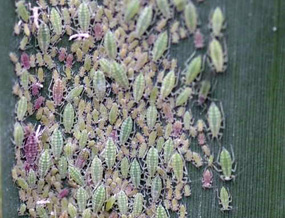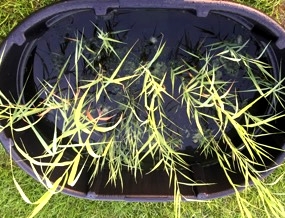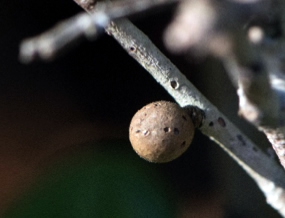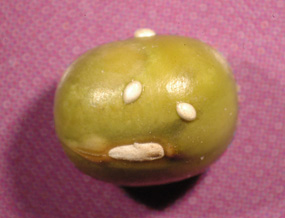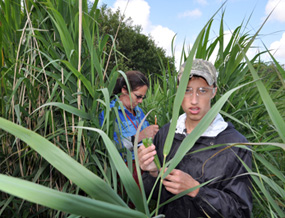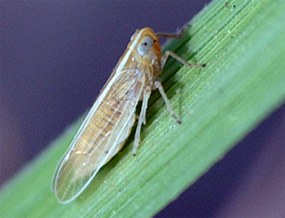Current Graduate Students
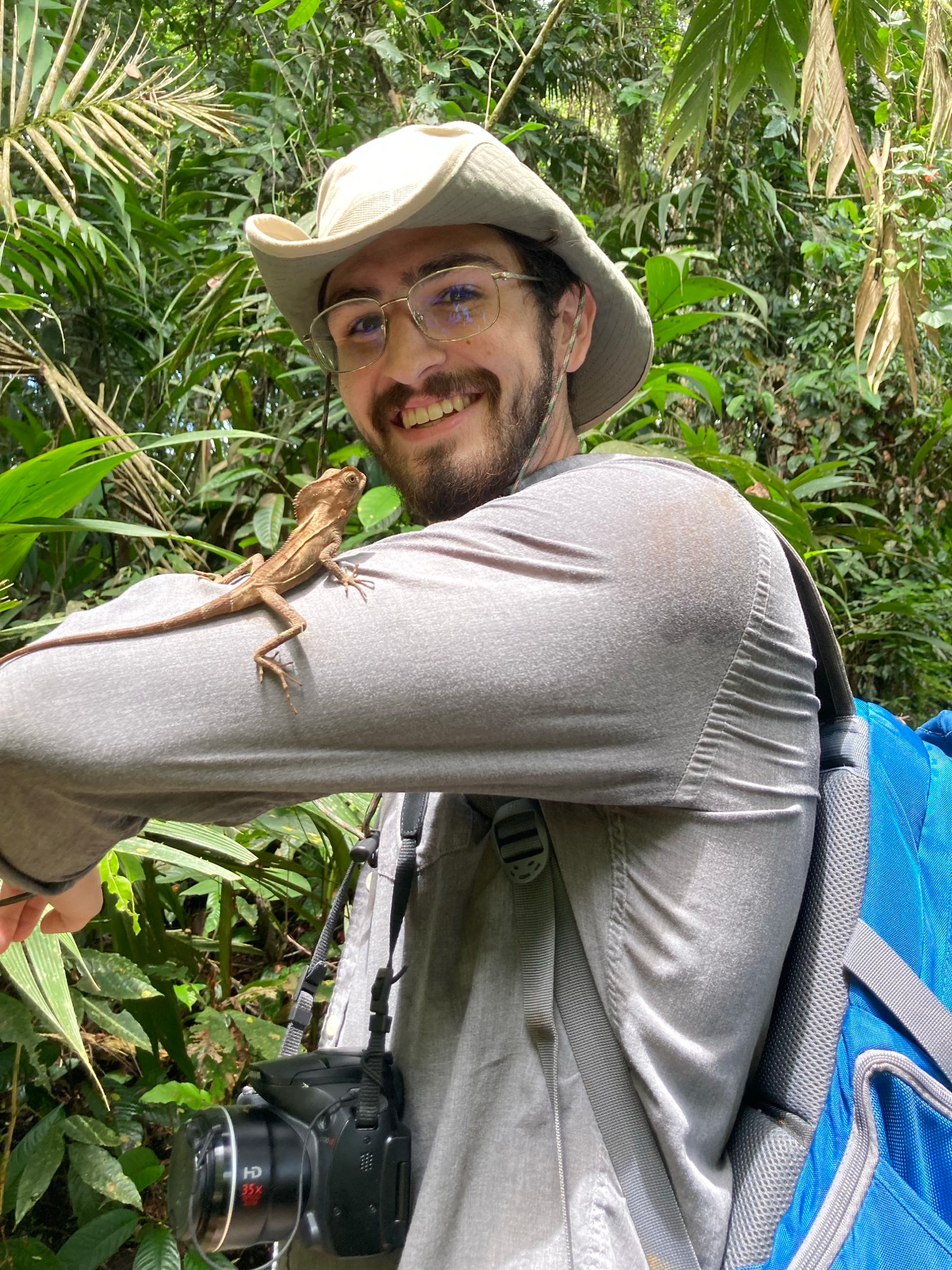
Aaron Krivchenia
Ph.D. student (2021-2025)
Aaron enrolled in the PhD program in the fall of 2021. He is interested in studying the effects of habitat fragmentation, conditional dispersal, interspecific competition and predation on the population dynamics and coexistence of species from the patch to the landscape level. His research focuses on Tribolium flour beetles and the fungal pathogen Beauveria bassiana and employs a combination of microcosm experiments and reaction-diffusion models.
Publications:
Cronin, J. T., J. Goddard II, A. Krivchenia and R. Shivaji. 2023. Density dependent within-patch movement behavior of two competing species. Evolution and Ecology. https://DOI.org/10.1002/ece3.10753.
- B.S., Rowan University, New Jersey (2020)
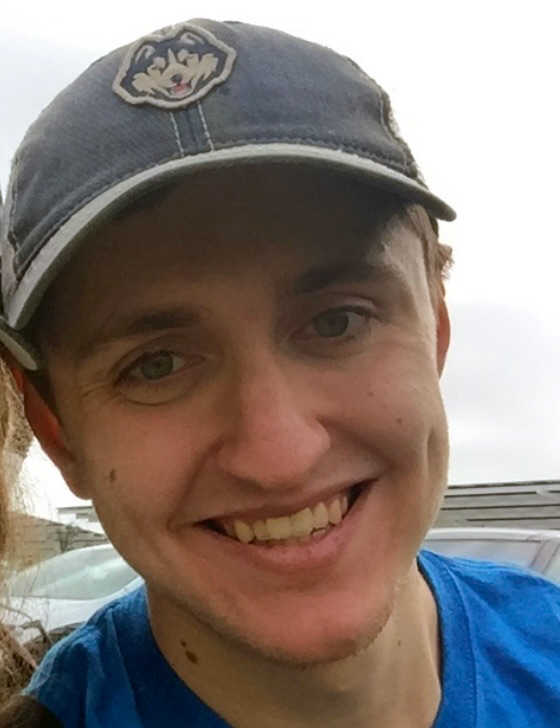
Andrew Mikolinski
Ph.D. student (2023-2028)
Andrew came to LSU with an interest in fire history and its effects on community structure. One of the best places in the world to study fire ecology is at Archbold Biological Station and this is where Andrew does his research. Specifically, he is studying the effects of time-since-fire and dispersal limitation on the structure of the arthropod community associated with scrub oaks.
- B.S., University of Connecticut (2021)
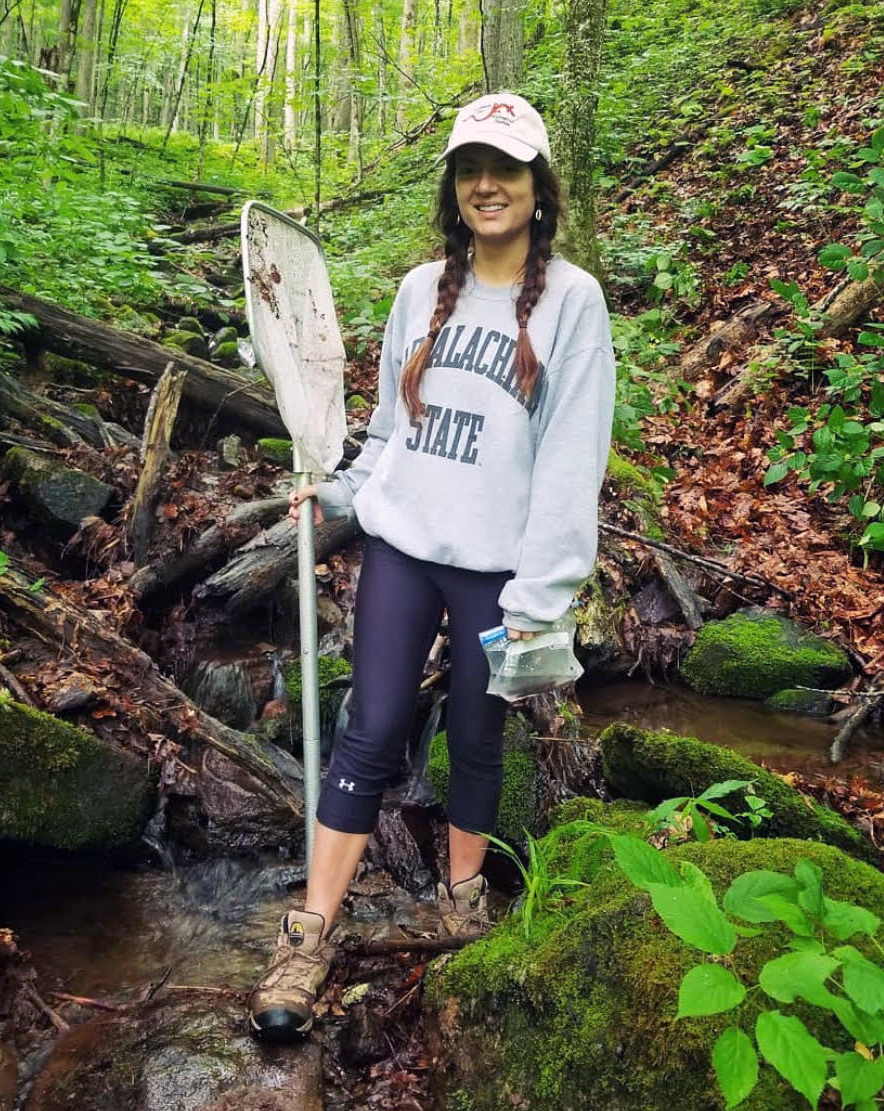
Sarah Roy
M.S. student (2023-2025)
Sarah’s research interests are somewhat of a departure from the work normally conducted in my lab. Her thesis research focuses on the broadscale geographic and climatic niches of dwarf salamanders (Eurycea spp.) in the southeastern United States. Once classified as a single species, Eurycea is now considered to be five distinct species. Sarah is developing the first ecological niche model for this group.
- B.S., North Carolina State University (2017)
Research Associate
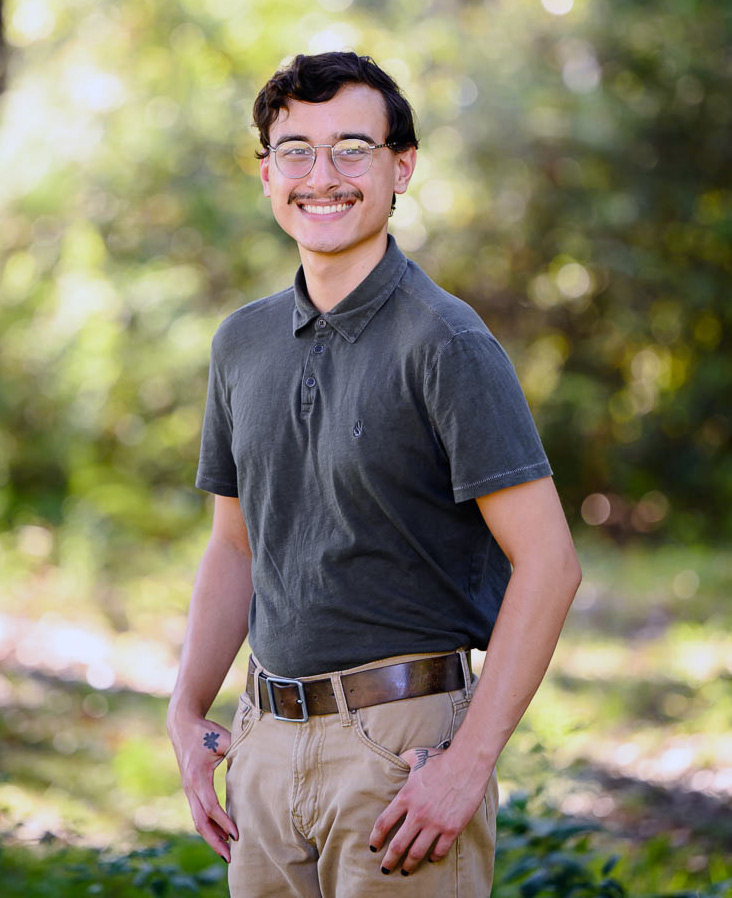
Ethan Guardado
Ethan recently joined my lab (February, 2025) and is going to play an integral role in our research on the invasion of taro following the dieback of Phragmites australis.
- B.S., Purdue University (2024)
Undergraduate Students
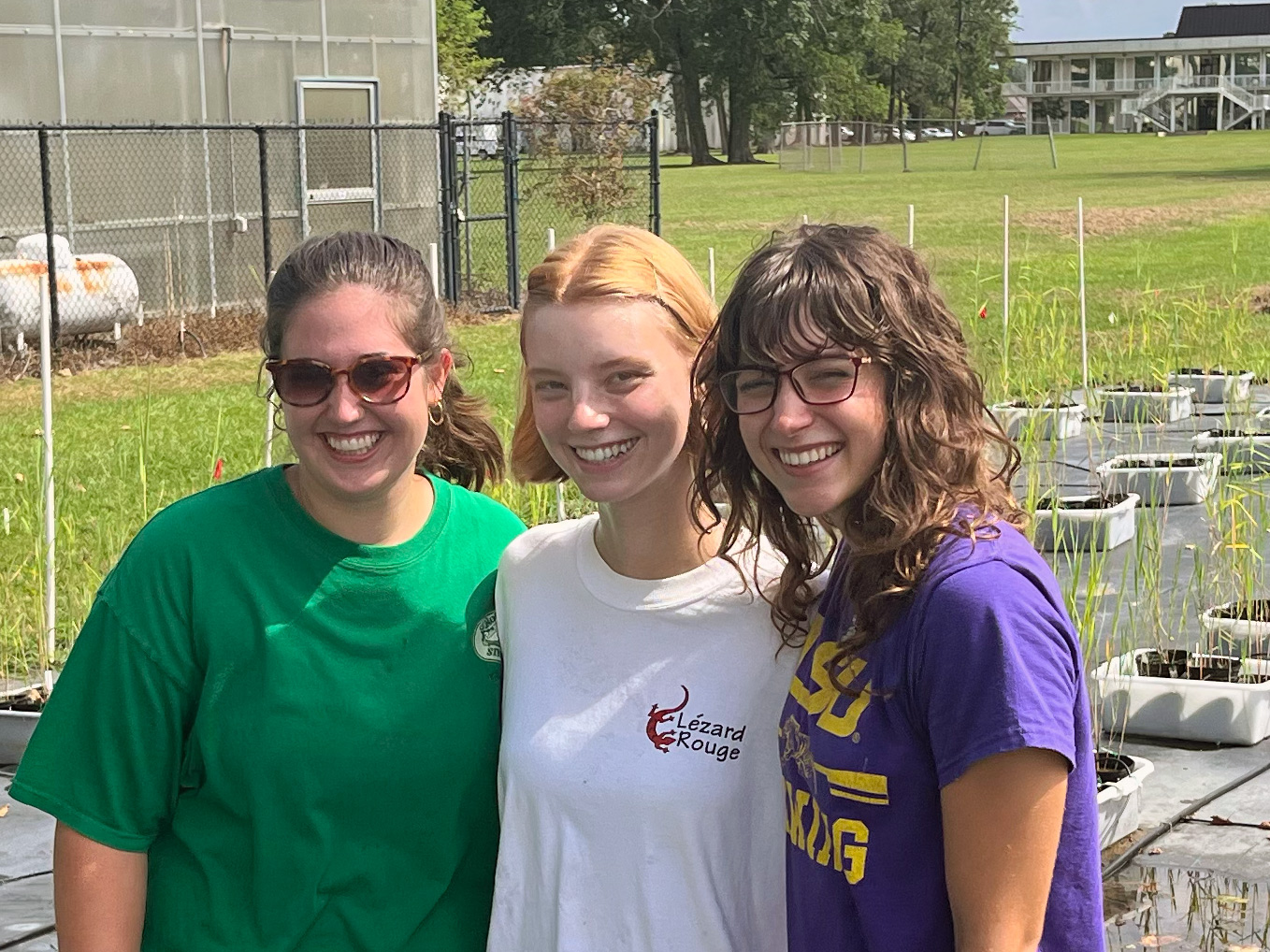


Past Graduate Students
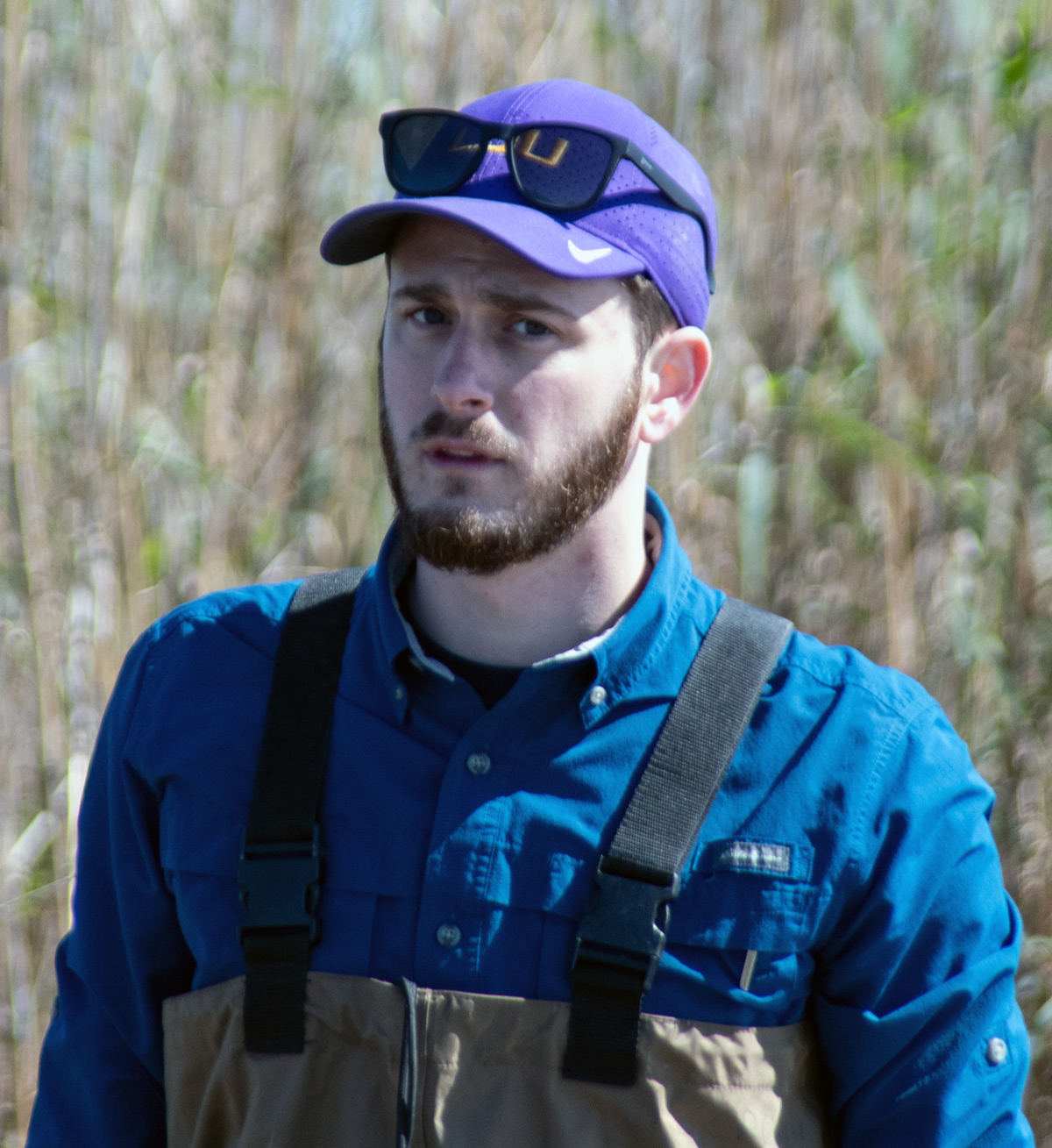
Joseph Johnston
M.S. Louisiana State University (2024)
Joe joined my lab in 2018 as a research associate, making significant contributions to our long-term project that focuses on Phragmites australis dieback in the Mississippi River Delta. He moved on to other things after two years but the pull of the marsh was too strong. In 2022, Joe decided to come back to LSU to pursue an MS degree. His thesis research focused on the invasion of Colocasia esculenta (taro) following dieback of P. australis. His common-garden experiment demonstrated that taro and P. australis compete with each other and that taro-soil microbes play an important role in mediating those interactions.
- B.S., University of Rhode Island (2018)
- M.S., Louisiana State University (2024)
- Current Position:
- Coastal Protection and Restoration Authority
- Baton Rouge, LA 70802 USA
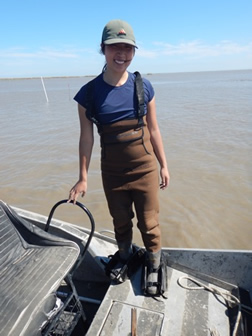
Herie Lee
M.S. Louisiana State University (2021)
Herie was formerly a graduate student in my lab, earning her M.S. degree in 2021. She was part of the team of researchers studying the causes and consequences of widespread dieback of the wetland grass, Phragmites australis (Roseau cane) in the Mississippi River Delta (for details, see: Roseau cane (Phragmites australis) Dieback in the Mississippi River Delta). Herie’s thesis research focused on 1) the chemical profiles of healthy and dieback soils and their impacts on Phragmites growth, and 2) the restoration of marsh habitats that have suffered dieback.
- B.S., Louisiana State University (2018)
- M.S., Louisiana State University (2021)
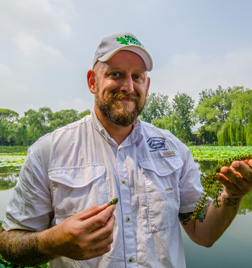
Nathan E. Harms
Ph.D. Louisiana State University (2020)
Nate is a research biologist with the U.S. Army Engineer Research and Development Center in Lewisville, TX. While employed with the Corps, he earned his PhD in my lab in 2020. Nate’s dissertation research focused on the biological control and management of wetland invasive plant species. Specifically, he studied flea beetle (Agasicles hygrophila) control of alligatorweed (Alternanthera philoxeroides). Historically, flea beetles have been very successful in controlling alligatorweed but an interesting phenomenon is now occurring with this system. Alligatorweed has been expanding northward but the flea beetles have lagged behind. Nate published six papers directly from his dissertation along with numerous other publications associated with his job with the Corps.
- B.S., University of Texas (2003)
- M.S., University of North Texas (2010)
- Ph.D., Louisiana State University (2020)
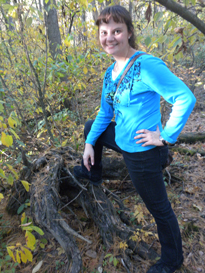
Rachel Harman
Ph.D. Louisiana State University (2020)
Rachel's dissertation focused on the effects of density-dependent emigration (DDE) on the population dynamics of competing species. She was particularly interested in comparing traditional forms of DDE (where dispersal increases linearly with density) with non-tradition forms such as negative or U-shaped DDE (see Harman et al. 2020). She was also interested in life-history tradeoffs at range margins using Tribolium flour beetles as a model system. Rachel completed her PhD in 2020 and is currently a postdoctoral associate in Tania Kim’s lab at Kansas State University.
- View or download Rachel's dissertation.
- More about Density-Dependent Emigration and Predator-Prey Population Dynamics
- B.S., Indiana University, Purdue University Fort Wayne (2012)
- M.S., Indiana University, Purdue University Fort Wayne (2014)
- Ph.D., Louisiana State University (2020)
- Current Position:
- Postdoctoral Associate
- Department of Entomology
- Kansas State University
- Manhattan, KS, 66506, USA
D. Lori Radunzel-Davis
M.S. Louisiana State University (2019)
Lori was jointly advised by Erik Aschehoug (Norwegian University of Life Sciences) and me. She studied plant-soil feedbacks in cogongrass (Imperata cylindrica), specifically focused on legacy effects on native plant species.
- B.S., University of Wisconsin
- M.S., Louisiana State University (2019)
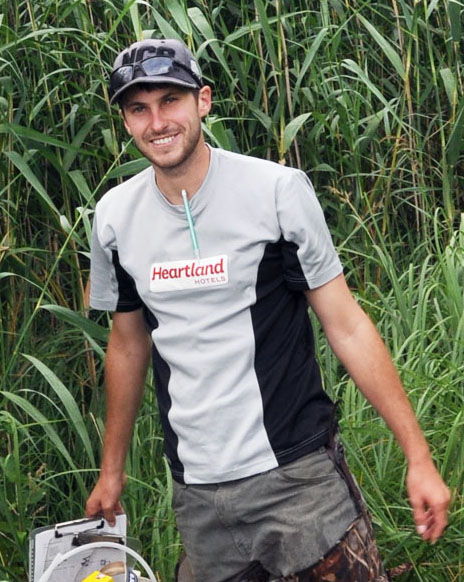
Warwick Allen
Ph.D. Louisiana State University (2017)
Warwick’s dissertation focused on two main research areas: invasive plant - herbivore - predator interactions and how they vary in space (see Allen et al 2017) and direct and indirect effects of soil microorganisms on invasion success and plant-plant interactions. His research focused primarily on the wetland invader, Phragmites australis. After graduating in 2017, Warwick has moved on to a postdoc at Lincoln University in New Zealand.
- View or download Warwick's dissertation.
- More about "The Ecology and Evolution of Latitudinal Gradients in Plant Defenses"
- B.S., Lincoln University, New Zealand (2009)
- Ph.D., Louisiana State University (2017)
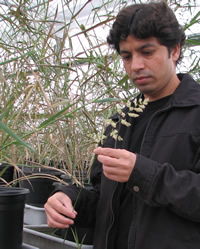
Ganesh Bhattarai
Ph.D. Louisiana State University (2015)
Ganesh's research focused on a large-scale, biogeographic approach to studying invasive plant species. Chapters in his dissertation addressed the effects of large-scale disturbances on the proliferation and spread of the invasive plant, Phragmites australis, the ecology and evolution of latitudinal gradients in P. australis - herbivore interactions, and apparent competition between native and invasive genotypes of P. australis and how it varies with latitude.
- View or download Ganesh's dissertation.
- More about "Effects of Large-Scale Disturbances on the Proliferation and Spread of
Phragmites australis "
- B.S., Prithvi Narayan Campus, Tribhuvan University, Nepal (1997)
- M.Sc., Central Department of Botany, Tribhuvan University, Nepal (2000)
- M.S., Texas Christian University (2007)
- Ph.D., Louisiana State University (2015)
- Current Position:
- Postdoctoral Associate
- Department of Entomology
- Kansas State University
- Manhattan, KS, 66506, USA
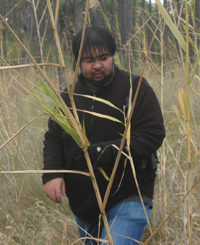
Anthony Chow
M.S. Louisiana State University (2014)
Anthony's research focused on the latitudinal variation in competitive ability of Phragmites australis and its role in invasion success.
- B.S., University of Tennessee (2009)
- M.S., Louisiana State University (2014)
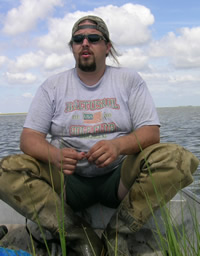
Forrest Dillemuth
Ph.D. Louisiana State University (2012)
Impact of invasive plant species on community structure. Forrest is interested in the invasion and spread of brome grass (Bromus inermis) in the tall-grass prairies of the Great Plains. His research has shown that brome is rapidly displacing native grasses, and altering the dispersal behavior and increasing the extinction risk of native insect species.
Dissertation Title: Invasion of smooth brome into North American tall-grass prairies: impact on native plant/herbivore species and mechanisms responsible for successful invasion.
- B.S., Louisiana State University (2003)
- Ph.D., Louisiana State University (2012)
- Postdoctoral Associate, Louisiana State University
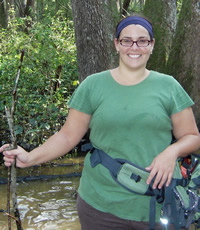
Amanda Accamando
M.S. Louisiana State University (2011)
For many plant speices, chemical and morphological defenses against herbivory induced upon herbivore attack. A plant's resistance to herbivory also may be influenced indirectly by its neighbors, that is, by the diversity and composition of the plant community. Amanda's objective is to examine how the efficacy of induced defenses is influenced by the context of the community. She plans to manipulate the species composition and defensive strategies (e.g., constitutive or induced defense levels) of neighboring plants and quantify their effects on the herbivory of a target plant species (soybeans) that either possess or lack the ability to induce a defense.
- B.S., State University of New York, Geneseo (2000)
- M.S., Louisiana State University (2011)
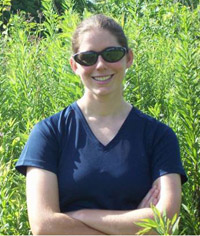
Alyssa Hakes
Ph.D. Louisiana State University (2010)
Mechanisms Promoting Spatial and Temporal Variability in Plant Defense
- B.S., University of Illinois (2003)
- Ph.D., Louisiana State University (2010)
- Postdoctoral Associate, Florida State University (2010-2012)
- Current Position:
- Associate Professor
- Department of Biology
- Lawrence University
- Appleton, WI
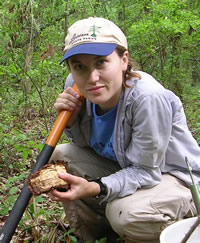
Heather Jackson
Ph.D. Louisiana State University (2010)
From Indidvidual Dispersal Behavior to the Multiscale Distribution of a Saproxylic Beetle.
- B.S., Brigham Young University (2001)
- M.S., Brigham Young University (2004)
- Ph.D., Louisiana State University (2010)
- Postdoctoral Associate, Carelton University, Ottawa, Canada
- Postdoctoral Associate, University of Tennessee, Knoxville, TN
- Current Position:
- Instructor
- Department of Fish, Wildlife, and Conservation Biology
- Colorado State University
- Fort Collins, CO 80523
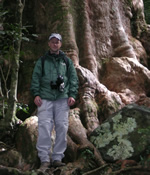
Kyle Haynes
Ph.D. Louisiana State University (2004)
Landscape heterogeneity and the spatial ecology of a prairie planthopper.
- B.S., University of California, Santa Barbara (1994)
- M.S., Utah State University (1998)
- Ph.D., Louisiana State University (2004)
- Current Position:
- Research Associate Professor and Associate Director
- Blandy Experimental Farm
- University of Virginia
- (webpage)

Allison Poff
M.S. University of North Dakota (2003)
Adaptive oviposition behaviour in the goldenrod stem galler, Eurosta solidaginis (Diptera: Tephritidae).
- B.S., University of Manitoba (1999)
- M.S., University of North Dakota (2003)
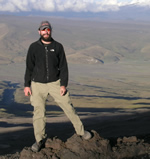
Mark Williams
M.S. University of North Dakota (2000)
Response of a Gall-forming Guild (Hymenoptera: Cynipidae) to Stressed and Vigorous Prairie Roses
- B.S., Missouri Southern State University (1998)
- M.S., University of North Dakota (2000)
- Ph.D., University of Wyoming
- Current Position:
- Forester
- Bureau of Land Management
- Salt Lake City, UT
Past Postdoctoral Associates
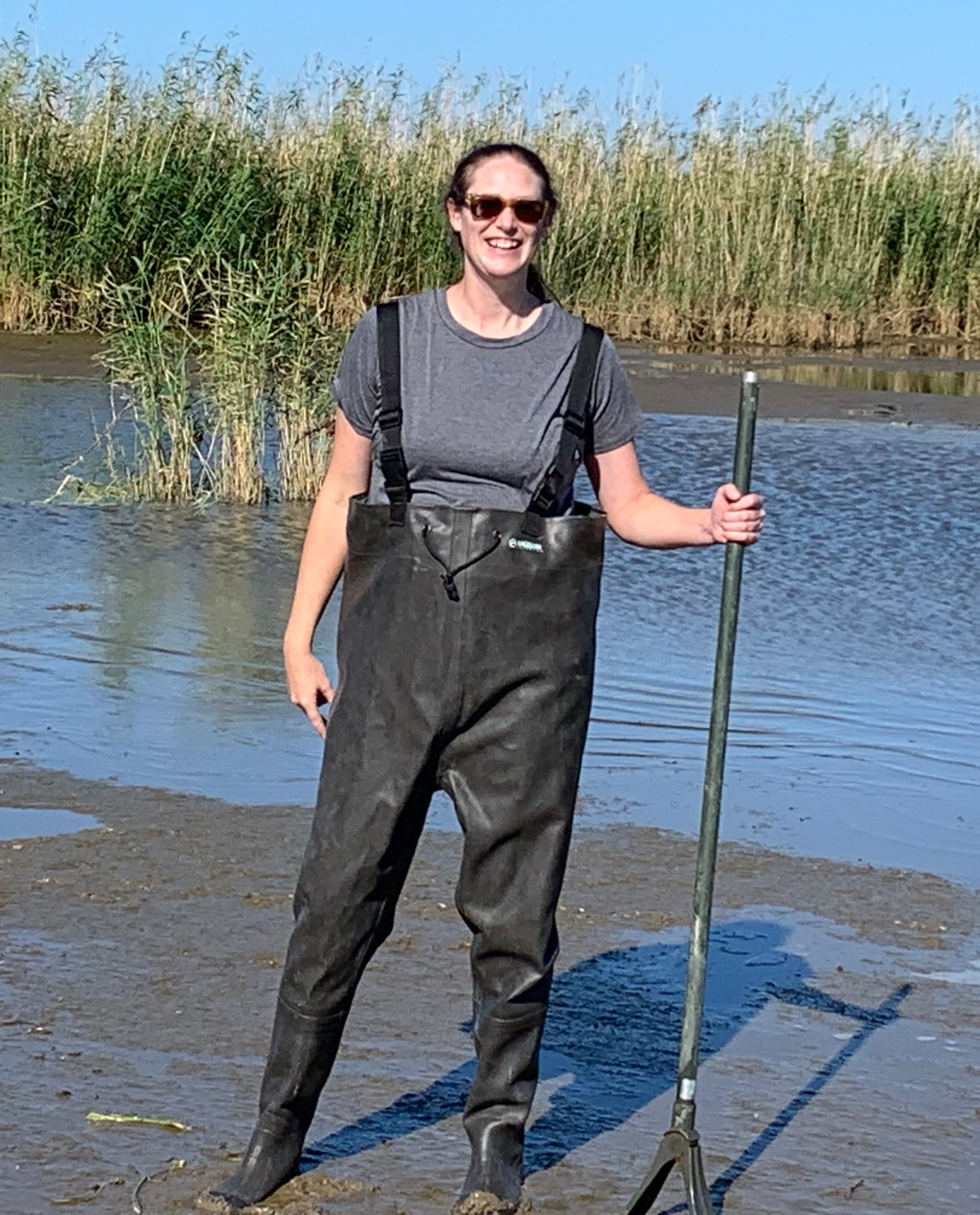
Dr. Andrea Glassmire
Andrea joined the lab in the spring of 2021 and worked with our team of researchers on the causes and consequences of widespread dieback of the wetland grass, Phragmites australis (Roseau cane) in the Mississippi River Delta (for details, see: Roseau cane (Phragmites australis) Dieback in the Mississippi River Delta). Andrea’s research focused on the photochemical landscape and its effects on multi-trophic species interactions. With the Phragmites system, she focused on 1) α and β biochemical diversity and plant resistance, 2) the effects of environmental stressors (flooding, nutrient additions and herbivory) on Phragmites metabolomics diversity, 3) the production of volatile organic compounds in response to plant stress and its effects on higher trophic levels and 4) the effects of climate change on Phragmites above- and belowground interactions. Publications from Andrea’s time at LSU include the following:
Salgado, A. L., A. E. Glassmire, B. E. Sedio, R. Diaz, M. J. Stout, J. Čuda, P. Pyšek, L. A. Meyerson and J. T. Cronin. 2023. Metabolomic Evenness Underlies Intraspecific Differences Among Lineages of a Wetland Grass. Journal of Chemical Ecology 49: 437-450.
Glassmire, A., A. Salgado, J. Johnston, R. Diaz and J. T. Cronin. 2024. The effects of environmental stressors on above- and below-ground phytochemical diversity of a threatened wetland grass. Plants. https://doi.org/10.3390/plants13223133.
- B.S., University of Pittsburg (2008)
- Ph.D., University of Nevada, Reno (2017)
- Postdoctoral Associate, Michigan State University (2017-2021)
- Current Position:
- Assistant Professor
- Department of Entomology
- Michigan State University
- East Lansing, MI 48824
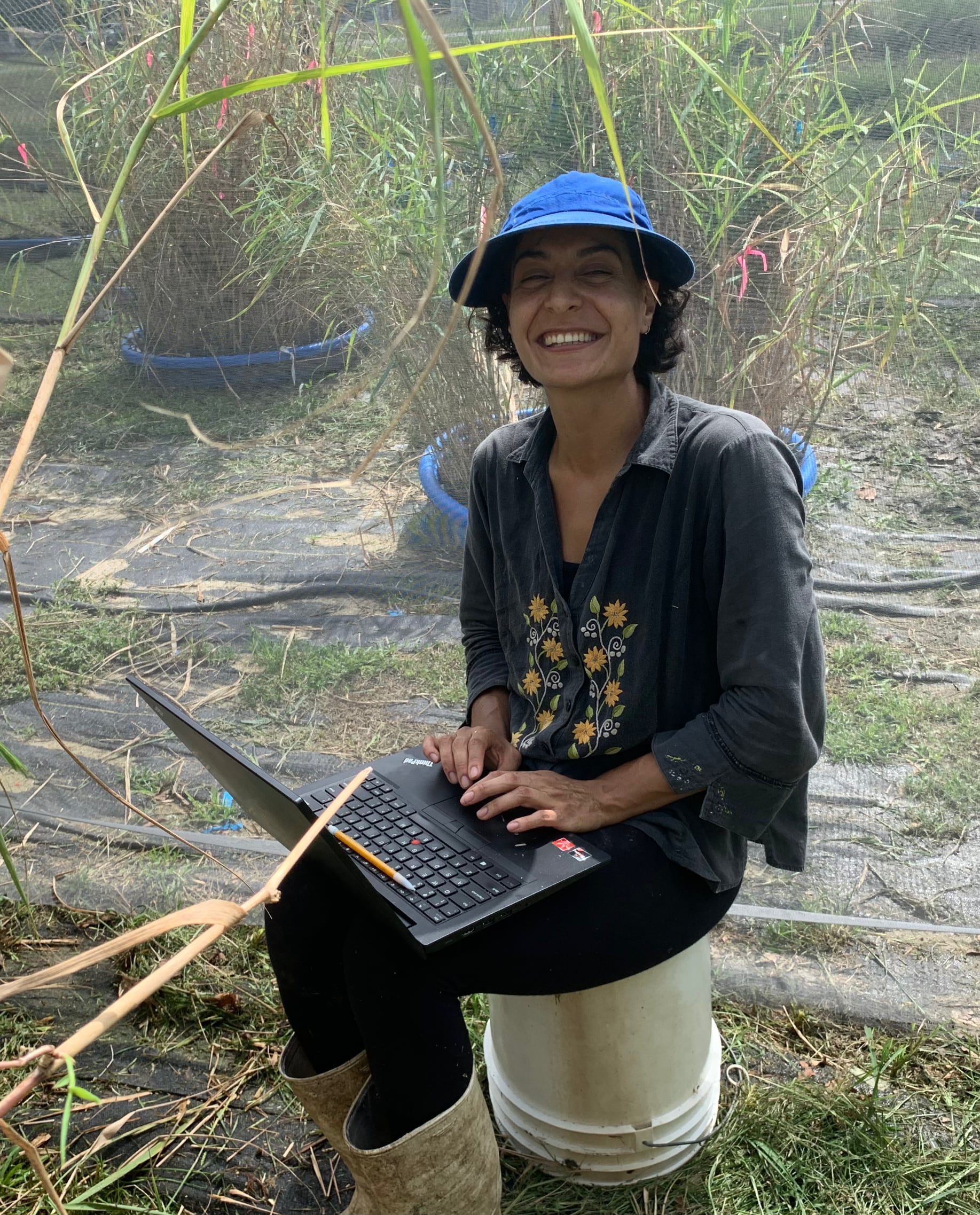
Dr. Ana Salgado-Maldonado
Ana was a member of the lab from the fall of 2020 to the spring of 2023. She was part of our large team of researchers studying the causes and consequences of widespread dieback of the wetland grass, Phragmites australis (Roseau cane) in the Mississippi River Delta (for details, see: Roseau cane (Phragmites australis) Dieback in the Mississippi River Delta). Ana’s research focused on the interactions between soil microbes and aboveground herbivores as mediated by the plant’s chemistry. Specifically, she was studying the metabolomic diversity associated with the different native and invasive lineages of Phragmites and how it changes in response to the presence/absence of soil microbes and scale insects. She published the following paper from this work:
Salgado, A. L., A. E. Glassmire, B. E. Sedio, R. Diaz, M. J. Stout, J. Čuda, P. Pyšek, L. A. Meyerson and J. T. Cronin. 2023. Metabolomic Evenness Underlies Intraspecific Differences Among Lineages of a Wetland Grass. Journal of Chemical Ecology 49: 437-450.
- B.S., Pontifical Catholic University of Ecuador (2014)
- M.S., University of Lausanne, Switzerland (2015)
- Ph.D., University of Helsinki, Finland (2020)
- Current Position:
- Lagniappe Program Coordinator
- Department of Biological Sciences
- Louisiana State University
- Baton Rouge, LA
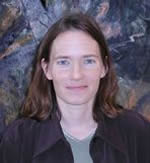
Kristen Baum
Kristen examined the impact of the matrix on the efficacy of corridors and stepping stones. She also played a significant role in the development of the study on dead-wood arthropods.
- More about "The Matrix Affects Connectivity of Corridors and Stepping Stones"
- More about "Management Effects on Dead-Wood Arthropods"
- B.S., The College of William and Mary (1994)
- M.S., Texas A&M University (1999)
- Ph.D., Texas A&M University (2003)
- Current Position:
- Professor and Associate Dean for Research
- Department of Zoology
- Oklahoma State University
- Stillwater, OK
- (webpage)
